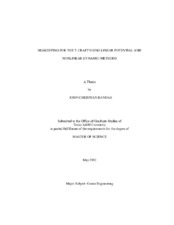| dc.description.abstract | A system of ordinary differential equations (ODE) is constructed for an air cushion vehicle (ACV). The system is simplified to an equation for the balance of the vertical forces and the equation for the adiabatic compression of the air in the cushion. Air pressure is constantly supplied into the system, but can leak out from underneath the edges of the cushion. A series of regular waves encounters the air cushion, causing a change in volume.
Additionally, a computational analysis of the seakeeping of a Surface Effect Ship (SES) is performed using the commercial software WAMIT, which uses low-order, linear potential panel method. The model of the T-Craft consists of catamaran hulls, rigid end skirts, and the interface between the air cushion and the water surface. Beyond the six rigid body degrees of freedom of the T-Craft, additional modes are added for the motion of the interface panels. To verify the method used, the model is benchmarked using computational data for a small-scale barge model and experimental data for a T-Craft model. A comparison is performed for the T-Craft with and without its cushion.
The solution for the nonlinear time-domain system is found numerically, and the stability of the system is studied by observing bifurcations with the incoming wave amplitude as the bifurcation parameter. The system experiences a period-doubling bifurcation, from a periodic orbit, to a subharmonic orbit, to a solution with multiple periods. Further increasing the wave amplitude increases the period doubling, eventually leading to chaotic behavior.
As a result of the linear-potential simulations, significant differences are found in the seakeeping of the T-Craft when on and off the cushion. These differences are caused by the direct and indirect effects of the cushion (added aerodynamics and a decreased draft). The RAO's of the craft experience changes in amplitude and phase, which will affect the multi-body relative motions. The time-domain model shows very chaotic behaviour that is presented visually in a bifurcation diagram. These linear potential and time-domain methods illustrate the complexity and importance of modelling air-cushion effects. | en |


